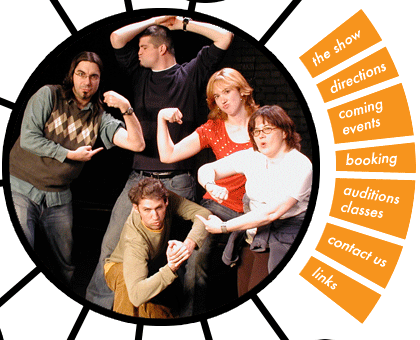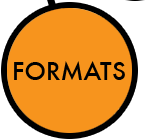



Arbor Day
We collect a list of made-up scene titles from the audience and then perform them in rapid succession. Game name (Arbor Day) chosen by our audience one fateful night.
Arbor Dayz
Same thing, but with edits thrown in by us, so you end up with some longer story lines mixed in with the shorter single scenes. Sort of Freestyle meets Arbor Day.
Black Widow
Several people engage in a banal activity. As their names are revealed, we freeze the action and ask the audience to endow one of the characters with a secret. We jump back in time to discover the history of the secret. Once the character is fleshed out, we jump back to the central scene, and work through until we've met all the characters in detail.
First Line Last Line
A freestyle with one rule: the last line of one scene is the first line of the next. Sometimes the last line of the last scene must be the first line of the first scene.
Freestyle
No rules. A series of scenes that may or may not be connected by a theme, a word, an object, a character, or a story line. We can jump back and forth in time, space is flexible, games are permitted. Anything goes.
Golden Seed
A freestyle guided by the audience. After each scene, we ask you for the "Golden Seed", a piece of information from that scene we will use to start the next scene. The Golden Seed could be a word, an image, a theme, anything.
GrooveProv
Kind of like musical chairs. We do a scene. The Music Master plays a new track when they want to end the scene, at which point we must dance. When the music stops, we freeze, and use our positions to start the next scene.
Octopus, or Rocktopus
A guided improvised play in which you help determine the back history. We develop you a story scene by scene. From time to time we stop and ask "Who or what from the previous scene would you like to know more about?" We go back in time to answer your question, then continue from where we left off in the present.
Slacker
A Medium-Form (longer than a game, not quite a Long-Form). Two-person scenes. One person leaves, we follow that person to a new scene, where they meet a new person. The new person leaves to go to meet a fourth person, who leaves to meet a fifth and so on. The last person to leave meets the first person from the first scene for the final scene of Slacker. Named for the movie by Richard Linklater, which worked like that.
Seven Stories
Just what it sounds like. You provide us with titles for seven stories. We tell you the stories.
Trifecta
A three-person form. At the start we ask you to give each of us a name and a secret or quirk. We then take turns telling the stories of the three characters, with the other two performers taking on the other people in their lives. At the end, the three main characters come together in one scene. Although Trifecta usually invloves three people, we've been known to do it with more, with the other performers filling in around the three main characters' stories.
Two-Man/Two-Person
Sometimes there are only two of us, due to other obligations and side projects. These two person shows are usually some of our best; the energy's high because we never get a chance to sit down! The format is generally a series of longer scenes with prompts from the audience. Look for an emphasis on character work.
Wheel of Fire
A Slacker format which incorporates flashbacks and other edits in the middle of scenes. Sometimes we call it SuperSlacker or Flaming Spear.










